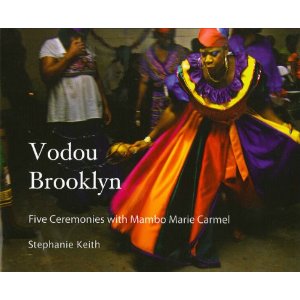Text by Anika Lani
Video interviews by Sohrab Saadat Ladjevardi
In Vodou Brooklyn, Five Ceremonies with Marie Carmel, photographer Stephanie Keith captures the frenetic and sometimes severe essence of what Haitians practicing Vodou call the lwa or spirits. Each lwa represents a tunnel of darkness alight with an internal divine/human adventure of the unknown. Stephanie Keith earned a Master’s degree in photography from New York University and a certificate in Photojournalism from the International Center of Photography. While embossing her professional career with photos and articles published in the New York Times, Rolling Stone and the Christian Science Monitor, she was called to explore local themes of religious adherence and popular culture.Three years ago she was invited to a party in a Brooklyn basement. Ms. Keith’s first attendance to a Haitian ceremony was no ordinary jam, but one replete with and women and men proffering themselves, beaming hubris peacock-style, as potential mates. Ms. Keith entered an uncharted dimension and became a puzzle piece to a larger specific ritual of drumming from an ethereal reservoir of elements that descend into experienced human forms. The spirits are sought for their cosmic powers as political and social stars of improvement and placation in Haitian life.
What did Ms. Keith do with this “newness” of spiritual flow? As a result of the ceremonial party to honor the energy of the lwa (spirit) Gede, Stephanie befriended Mambo Marie Carmel. She rode a wave of esoteric prayer rapidly increasing in urban areas where those of the African Diaspora congregate and worship, and chose to photograph sensitive and serious moments of the divine “working” its physical hosts through devout ritual propitiation and theater. This continuous re-enactment cleaves to unpredictable storytelling variables based on historical myths that accurately dramatize Haiti’s colonial and sovereign history while enriching a spiritual family with hope, faith, love, a good time and a stable future.
Haiti’s sweeping status around the world as just another poor free island in need of world bank aid periodically after a “natural disaster” invites unjust superstition about her religious belief systems and demeanor of her people. Religious experience, if voluntarily accepted and absorbed, begets, in a very individual manner, a constantly customized enchantment with God as a powerful corpus of information distributed through natural forces of earth, wind, fire, water and prophets. Many people of all cultures court communication with natural phenomena without rallying it into the name God or spirit. For some, nature just is what it is. For this particular spiritual family of Haitians who gather in Carnarsie, Brooklyn, though, forces of nature are God’s emissaries and wise counsel who demand payment for their appearance from incomprehensible yet still revelatory, live planes of speed and light.
Well, isn’t Stephanie Keith’s photographic research perfect fodder for the production of D grade science fiction movies that further alienate dominant familiar faiths, such as Islam and Christianity, from religions that are their sisters and brothers? The divine favors no one sect over another. That is a comfortable human claim used to exercise control of fear over energies of life and death that are impossible to actually harness. —-In Haitian Vodou, which originated in Dahomey, Africa, there are instances where glimpses of non material reality are granted through an expanded consciousness. Stephanie freezes these slivers of fate in tireless action. Young women smile sweetly in white cotton frocks and satin purple paisley dresses though they are adorned for the tricky spirit that rules the underworld with unabashedly ribald sexuality. Wide-eyed men who see only what they can see, grip their sweaty palms around consecrated black and steel daggers pantomiming a war and victory dance of Haitian predecessors, now lwas, who fought for their country’s liberation. The ceremonial participants are photographed spitting rum as a positive omen, stepping through fire to prove miraculous powers manifest while possessed by a spirit, and whispering advice to join in representing an aspect of the divine stream of earth’s gift by surrendering to a mambo or houngan (priestess or priest) initiation. The journey towards initiation must be tread poetically and responsibly as it is a refined road of existence for use towards celebrating and healing a complicated community of immigrant Haitians and those born in America. The photographs zoom in on the intuitive architecture of elaborate altars of gold and white silk, expensive and imported bottles of rum, lit tall glass encased candles, plates of crushed eggshells, corpulent vases of red, white, pink, yellow, violet and fragrant bouquets, mugs of dark coffee, and effigies of catholic saints. Swirls of cigar smoke culminate, to an initiate’s perception, in the shape of the spirit petitioned before inhabiting the body of the person poised to grant wishes. In these Brooklyn basements that are transformed from tepid storage areas into classic Haitian hounfors (homes of worship), boundaries of perception loosen through sacred ritual singing, praying, and focused drum patterns that speak far past the mundane ceiling towards a spectacular and respected cosmos.
Stephanie Keith’s photographs are careful to frame expressions of trauma, consternation, and bliss in resistance to running stereotypes of Haitian Vodou portrayed in the popular imagination. No bloodletting from the necks of chickens or super orgies color in the large pages delineating Haitian spiritual and coping life. Erroneous movie plots like Sugar Hill (1974), which uses a sexy woman to seek out the powers in Vodou as a funnel for revenge by leading a team of zombies to destroy the gangsters who murdered her man, find no legitimacy with Keith’s montage of local Brooklyn practice.Barring a temptation to stuff Vodou Brooklyn in a false pantheon of works that feed ignorance and strengthen a religious imperative that disconnects from a true inner spirit, Stephanie Keith’s portraits offer an everyday view of a people, well acquainted with struggle, firmly centered in their religious expression of solutions and blossoming processes of love and freedom.
Recommended links
Buy the book
More Vodou Brouklyn pictures
Another Anika Lani post in DBDBD


